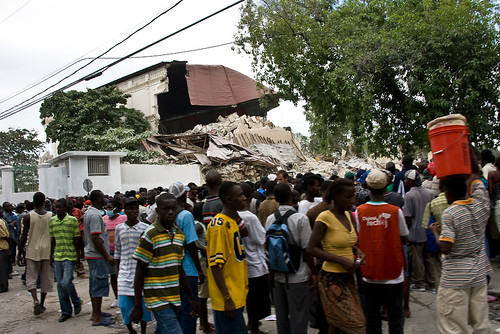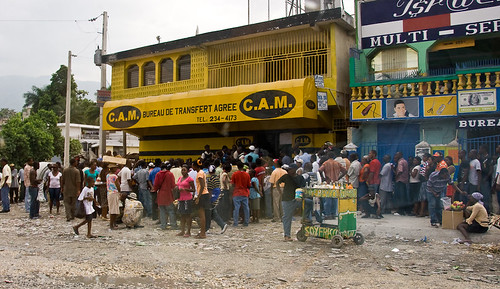
As Evan Hansen noted in an earlier post, the Haitian recovery will have to be down to earth, literally. Local food production is invaluable in a country where people struggle to feed themselves. For advice on this I sought out Geoff Lawton of the Australian Permaculture Research Institute. He answered my questions about how to strategize and deploy sustainable permaculture solutions across the country.
EVAN O'NEIL: Given the ecological degradation in Haiti, and the need for food and fuel, how can permaculture projects help rehabilitate the landscape and provide sustainable livelihoods?
GEOFF LAWTON: Permaculture projects can help through a holistic design approach that integrates people's ability, ingenuity, and skill-sets with the available resources that are locally understood. Integrating local people's skills together with local resources can increase community members' sense of self-reliance, have a unifying effect on the community, and empower local people to provide for their own needs, with the minimum amount of assistance from the outside world.
This process fosters and creates a sense of independence for local people in a situation that can be portrayed by the outside media as insurmountable. So the psychological and physical result of permaculture projects is that it creates a beneficial turnaround for the people and the landscape from a disaster situation to a meaningful future and recovery.
EO: What role can permaculture play in urban environments such as Port-au-Prince?
GL: Major solutions emerge out of major problematic situations. In Port-au-Prince, there are many solutions that can emerge, including the restructuring of built infrastructure in a way that creates hard-surface water runoff aimed at productive urban gardens; creating a microclimate through the recycling and redesign of the landscape; and implementing biological cleaning of urban grey- and blackwater waste.
Organic materials can be converted into high-quality inoculum compost useful for the production of extremely high-nutrient-dense food gardens within the urban and peri-urban landscape, where gardens would also include small animal systems, small aquatic systems, and medicinal food gardens.
Introducing and demonstrating appropriate alternate energy systems that can operate on a low economic investment and supply people with electricity would be an ideal inclusion and inspiration for local people as part of an empowerment and cooperative model.
A key reference and example for what is possible is given in the case of Cuba, with further information being available at www.pathtofreedom.com.
EO: Organizationally is there a management or ownership structure that you’ve found most sustainable? Do permaculture projects work best at a certain scale?
GL: The organizational structure most suitable for permaculture projects is management by a local nongovernmental organization operating as a nonprofit education and demonstration entity, where information is networked by the project locally, nationally, regionally, and internationally with the support and partnership of an internationally connected nonprofit NGO. This helps to pool the international skills and experience of its students, teachers, administrators, and project managers.
The education center functions best when it teaches courses for 25–35 people per site, and it is crucial that the education facility be open not just to local students but also to international students who are prepared to pay first-world international prices for education and internship programs and are inspired and encouraged by the fact their tuition provides a major part of the project's funding.
The infrastructure on these projects needs to operate as a dual-function example of local and renewable housing—i.e., energy efficient, constructed of local materials which are readily available, and affordable to local people.
An ideal land area for a project is a site that is typical of local land use, somewhere where the land is no longer productive or is a difficult production area for local people; somewhere where the land is not the worst, or the most difficult land and not the best or ideal land, but a piece of land that represents an average example of what local people have to deal with in their everyday life.
EO: How would you strategize the best sites around the country? Are there any challenges unique to the Haitian landscape?
GL: The over-exploitation of natural resources and the depletion of biodiversity in the landscape of Haiti creates a situation where the prioritization of good key-point positions in the landscape would be an imperative for a fast result, and getting a fast result would be a powerful way to inspire local people to extend and replicate the permaculture model. A key strategy is to identify specific water-harvesting points at the tops to the mid-slopes of watersheds, in order to supply gravity irrigation and organic nutrient flow to areas that are appropriately shallow in slope for an intensified, diverse, and interconnected productive yield.
These systems need to be set up within a practical distance of the population so that numbers of local people can be involved in the implementation and establishment, and through their involvment in this process they can get the added educational benefit of acquiring new knowledge and skills that can support them in supporting themselves, now and into the future.
EO: Some conservation organizations use the concept of cores and corridors to protect wildlife. Are there analogous benefits in permaculture? Would it make sense, for example, to connect farms to the national parks, or to the forested Dominican border, in a larger green network?
GL: Ecosystemic processes and principles are inherent and central within the design science of permaculture planning and recovery and blend perfectly with natural and conservation forest ecosystems within a contoured corridor pattern, watershed dendritic pattern, and also along human transport routes, within the urban or larger landscape area. Permaculture project designs always emphasize the integration and integrating benefits of harmonizing with natural landscape forms and profiles.
[PHOTO CREDIT: Manioc on a steep slope. By Nick Hobgood (CC).]


